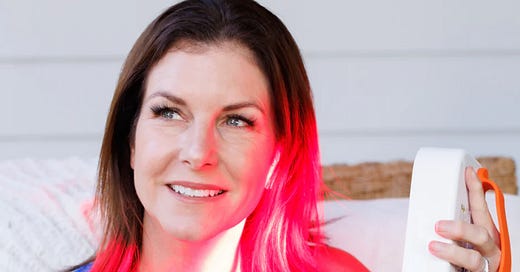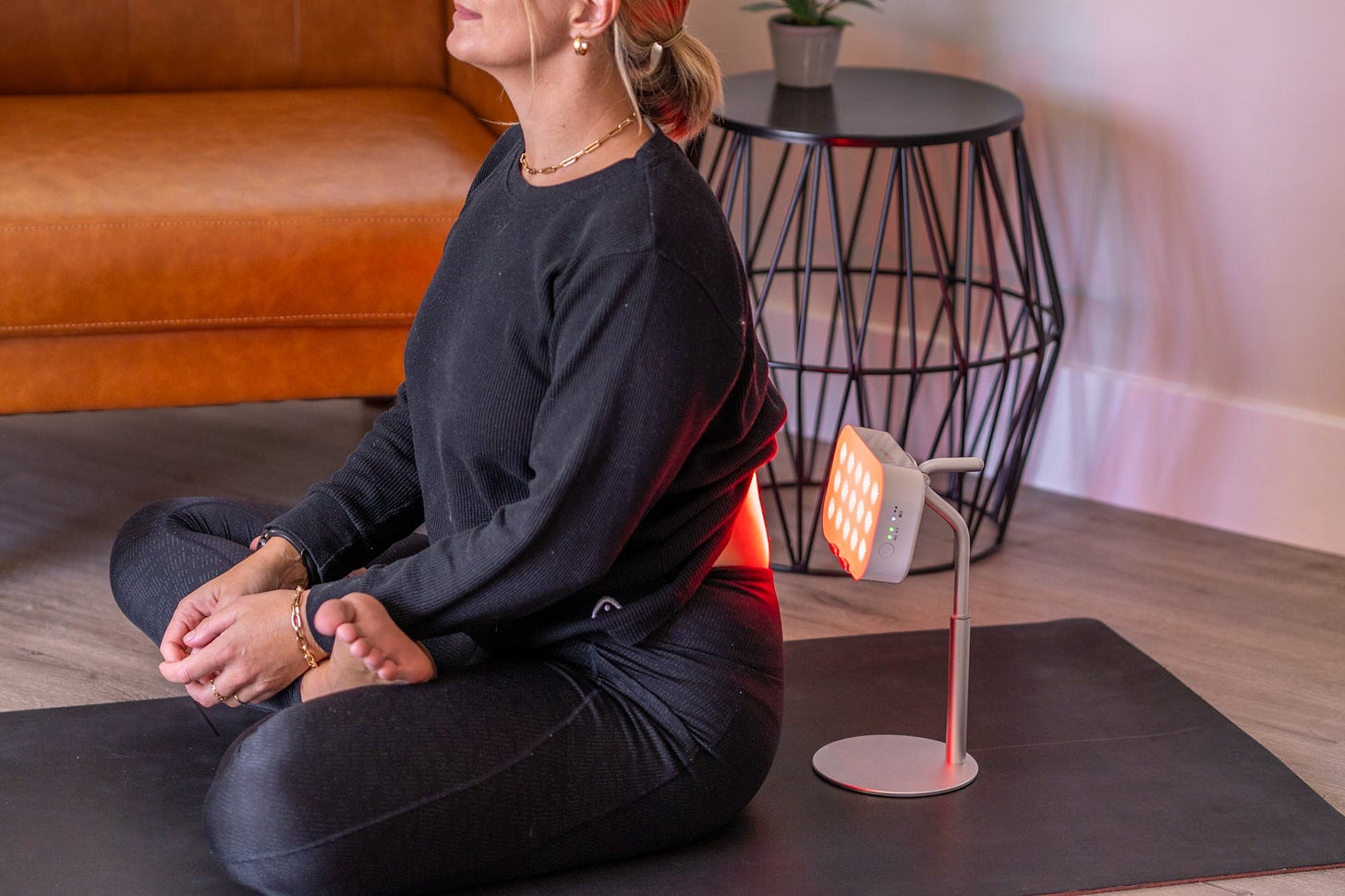What is red light therapy?
When mitochondria are activated by red light they produce more ATP and have been associated with better skin, mood, cognition, and less pain, and inflammation.
Light is perhaps one of the most under-utilized tools in health and wellness. It is fundamental and essential to life on earth.
However, our depleted ozone layer has allowed more UV to reach the earth’s surface, meaning it is easier to sustain sun damage from previously ‘normal’ sun exposures.
UV causes oxidative stress = increased risks of skin cancer and ageing. Effects we don’t want.
One way to get some of the benefit of light without UV damage is with a red light therapy machine, devoid of UV light.
Most Americans spend 90% of their time indoors, this means that we are not getting the light exposure we need for optimal health too.
If you spend most of your time indoors, you may want to get a dose of this important nutrient via red light therapy.
WHAT IS RED LIGHT THERAPY?
In essence, red light charges the batteries inside our cells (the mitochondria) and allows the cell to do what it’s meant to do better.
The Science
The battery inside our cells, aka the mitochondria, has receptors that are activated by red light. When mitochondria are activated:
More ATP is produced - this is the energy that drives most cellular functions. The more ATP a cell has, the better it can work.
Nitric oxide is produced - this dilates blood vessels to improve blood flow and deliver more nutrients + oxygen to the tissues, aiding with tissue repair and reducing inflammation
In other words, red light therapy gives a boost to the cell. Whatever the cell can do, it can do it better with a dose of red light therapy.
Since every cell in our body needs energy to work, red light can support a variety of healthy functions from healthier skin to lower inflammation.
Sounds good but is there any scientific research to back this up?
Did you know there are 2000+ published studies on photobiomodulation and LLLT (low-level light therapy)? These are two fancy names for red light therapy.
Here are a few benefits that have been studied in petri-dish, animal and human studies:
Healthy skin includes increased collagen production, increase elasticity, texture, and reduced inflammation in the skin1234
Aids the body's natural ability to heal wounds9
Muscle recovery10
Improved rest at night11
The advantage of red light therapy is that it is devoid of the skin-damaging UVA and UVB which is present in sunlight - and so it doesn’t hurt or burn the skin.
It is not the same type of light used in tanning booths, and it doesn’t expose your skin to any damaging UV rays.
Treatments may be applied at your doctor’s office, dermatologist practices, physical therapy centers and even salons and dental offices, but these can be expensive and add up.
If you like the read studies, let’s geek out!
So far, RLT has been shown to have the following benefits (these are the fairly well-researched indications):
Skin rejuvenation
Clinical studies have shown that photobiomodulation with both laser and LED based red light therapy devices have the capacity to increase collagen production, reduce wrinkles, and help rejuvenate the skin.
Researchers gathered 136 volunteers and measured collagen thickness on the skin, took pictures of their cosmetic imperfections, and did a computerized digital profilometry.12
They found that the group using red light therapy significantly improved overall skin complexion, skin feeling, profilometrically assessed skin roughness, and ultrasonographically measured collagen density.
In another randomized, double-blind, placebo-controlled trial, Seventy-six patients with facial wrinkles were treated with quasimonochromatic LED devices on the right half of their faces. All subjects were randomly divided into four groups treated with either 830nm alone, 633nm alone, a combination of 830 and 633nm, or a sham treatment light, twice a week for four weeks. They measured Serial photography, profilometry, and objective measurements of skin elasticity and melanin. They found a reduction (maximum 36%) in wrinkles, improved elasticity (max 19%), and also biochemical markers of increased fibroblast activity (fibroblasts make collagen and the deduction is that the more fibroblast activity, the more collagen made, the more collagen made the more supple and youthful your skin. Because collagen starts decreasing in our 20s.)
I personally have noticed a great difference in my skin after using it consistently (you do need to use it for 5-6 weeks consistently to see a result, and whether you see a difference depends on the device + treatment times) - plumper, more irradiant, fewer breakouts, and no wrinkles (yet) at age 45.
Pain and inflammation
Several studies, including a meta-analysis [this is a type of study that is fairly well respected] have concluded that low-dose laser therapy (LLLT) may be an effective modality in reducing discomfort and soreness in adults with musculoskeletal disorders.
Another meta-analysis concluded that the LLLT in patients with plantar fasciitis (tendinitis of the foot), significantly relieves the heel pain and the efficacy lasts for 3 months after [treatment]. Similarly, a systematic review also found pain relief in those with TMJ dysfunction.
Wound healing
In a systematic review authors found that LLLT when used in skin burns improved microcirculation and cellular proliferation leading to an accelerated healing process, however, most studies cannot agree on a standard protocol or treatment dose. So more research is needed.
Muscle recovery
LLLT’s main acceptor is the mitochondria. Muscles are some of the most densely rich sources of these powerhouses. In analyzing its effect on muscle fatigue and injury we see that LLLT helps stimulate the repair of muscle while reducing inflammation and oxidative stress.
Many athletes use it before working out (preconditioning) to boost their performance, and then after workouts to prevent soreness and reduce the likelihood of injuries.
The benefits don’t stop here. There is also research showing the possible benefit of red light therapy in dementia, Parkinson’s, depression, cellulite, and fat loss - more research is needed, but this is a very exciting area with more research being done all the time.
Much of the discrepancy in the research is due to variations in our response to red light. Just like not one diet fits everyone, we also respond to light differently, so the ideal dose and treatment time can vary between individuals, making it difficult to provide one standard protocol for everyone.
Add to that, every device has different power, and irradiance, with many units on the market lacking any third-party verification of irradiance, and poor quality control, making it even more difficult to give a standardized protocol.
If you do want to try red light therapy, first consult with your doctor to ensure you don't have any contraindications, and then do your research to pick a device that has been 3rd party tested for safety, irradiance, and EMF.
Is flicker a concern?
Flicker is a concern mainly with ambient lighting when exposed for for prolonged periods, e.g. >1 hour. It may be associated with headaches, eye strain, etc. Flicker is mainly a moot point for a hand-held device powered by a battery (i.e. run on DC vs AC).13 However, it is something to look out for if you are purchasing one of the bigger units that plug into the wall electrical socket, if you are particularly sensitive, or if you plan to use it for ambient lighting.
However, if you are only using it 5-10 minutes a day, not looking at the light (you shouldn't be anyway), it's not really something I am concerned about personally.
What do I use?
I could not find a portable red light therapy unit that ticked ALL my boxes - I wanted something portable, easy to use, big, and powerful. Units on the market are either under-powered or didn't have any 3rd party lab-tested EMF or safety testing (the majority fly under the radar and are not even registered with the FDA when they should be).
Enter LUMEBOX
LUMEBOX
Lab-tested to be 80% more powerful than leading brand
Has more bulbs so covers 25% more surface area
Each bulb emits BOTH NIR and Red light - the 2 most studied wavelengths that are beneficial
Has a longer battery life, shorter charging time (each full charge gives around 110-130 minutes use time)
Low EMF
3rd party tested for safety: meets IEC 60601-1, 60601-11, 62471 and meets Good Manufacturing Practices (GMP) under ISO 13485.
Every batch 3rd party is inspected by SGS.
Registered with the FDA.
LUMEBOX discount link - get $260 off here
Originally written March 3rd 2023
Lee SY1, Park KH, Choi JW, Kwon JK, Lee DR, Shin MS, Lee JS, You CE, Park MY.A prospective, randomized, placebo-controlled, double-blinded, and split-face clinical study on LED phototherapy for skin rejuvenation: clinical, profilometric, histologic, ultrastructural, and biochemical evaluations and comparison of three different treatment settings. J Photochem Photobiol B. 2007 Jul 27;88(1):51-67. Epub 2007 May 1.
Weiss RA, Mcdaniel DH, Geronemus RG, Weiss MA. Clinical trial of a novel non-thermal LED array for reversal of photoaging: clinical, histologic, and surface profilometric results. Lasers Surg Med. 2005;36(2):85-91.
Clijsen R, Brunner A, Barbero M, Clarys P, Taeymans J. Effects of low-level laser therapy on pain in patients with musculoskeletal disorders: a systematic review and meta-analysis. Eur J Phys Rehabil Med. 2017;53(4):603-610.
Wang W, Jiang W, Tang C, Zhang X, Xiang J. Clinical efficacy of low-level laser therapy in plantar fasciitis: A systematic review and meta-analysis. Medicine (Baltimore). 2019;98(3):e14088.
Xu, Gang-Zhu & Jia, Jie & Jin, Lin & Li, Jia-Heng & Wang, Zhan-Yue & Cao, Dong-Yuan. (2018). Low-Level Laser Therapy for Temporomandibular Disorders: A Systematic Review with Meta-Analysis. Pain Research and Management. 2018. 1-13. 10.1155/2018/4230583.
Brassolatti P, De andrade ALM, Bossini PS, Otterço AN, Parizotto NA. Evaluation of the low-level laser therapy application parameters for skin burn treatment in experimental model: a systematic review. Lasers Med Sci. 2018;33(5):1159-1169.
Mosca RC, Ong AA, Albasha O, Bass K, Arany P. Photobiomodulation Therapy for Wound Care: A Potent, Noninvasive, Photoceutical Approach. Adv Skin Wound Care. 2019 Apr;32(4):157-167. doi: 10.1097/01.ASW.0000553600.97572.d2. PMID: 30889017.
Shaiane Silva Tomazoni, Caroline dos Santos Monteiro Machado, Thiago De Marchi, Heliodora Leão Casalechi, Jan Magnus Bjordal, Paulo de Tarso Camillo de Carvalho, Ernesto Cesar Pinto Leal-Junior, "Infrared Low-Level Laser Therapy (Photobiomodulation Therapy) before Intense Progressive Running Test of High-Level Soccer Players: Effects on Functional, Muscle Damage, Inflammatory, and Oxidative Stress Markers—A Randomized Controlled Trial", Oxidative Medicine and Cellular Longevity, vol. 2019, Article ID 6239058, 12 pages, 2019.
Khan, I., Rahman, S.U., Tang, E. et al. Accelerated burn wound healing with photobiomodulation therapy involves activation of endogenous latent TGF-β1. Sci Rep 11, 13371 (2021).
Ferraresi C, Huang YY, Hamblin MR. Photobiomodulation in human muscle tissue: an advantage in sports performance? J Biophotonics. 2016 Dec;9(11-12):1273-1299. doi: 10.1002/jbio.201600176. Epub 2016 Nov 22. PMID: 27874264; PMCID: PMC5167494.
Valverde, Audrey1; Hamilton, Catherine2; Moro, Cécile1; Billeres, Malvina1; Magistretti, Pierre3; Mitrofanis, John1,4,*. Lights at night: does photobiomodulation improve sleep?. Neural Regeneration Research 18(3):p 474-477, March 2023. | DOI: 10.4103/1673-5374.350191
Wunsch A, Matuschka K. A controlled trial to determine the efficacy of red and near-infrared light treatment in patient satisfaction, reduction of fine lines, wrinkles, skin roughness, and intradermal collagen density increase. Photomed Laser Surg. 2014 Feb;32(2):93-100. doi: 10.1089/pho.2013.3616. Epub 2013 Nov 28. PMID: 24286286; PMCID: PMC3926176.
Ferraresi C, Hamblin MR, Parizotto NA. Low-level laser (light) therapy (LLLT) on muscle tissue: performance, fatigue and repair benefited by the power of light. Photonics Lasers Med. 2012;1(4):267-286.











